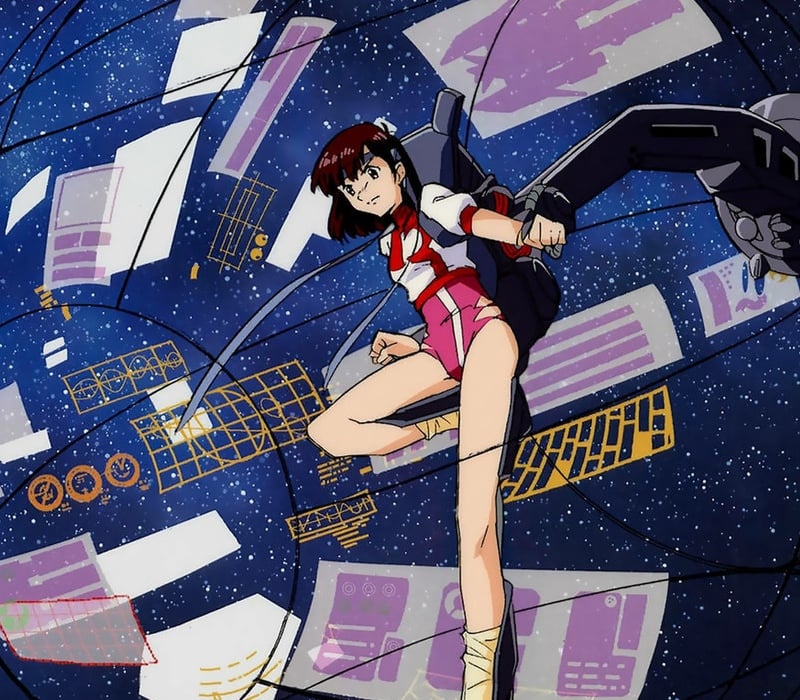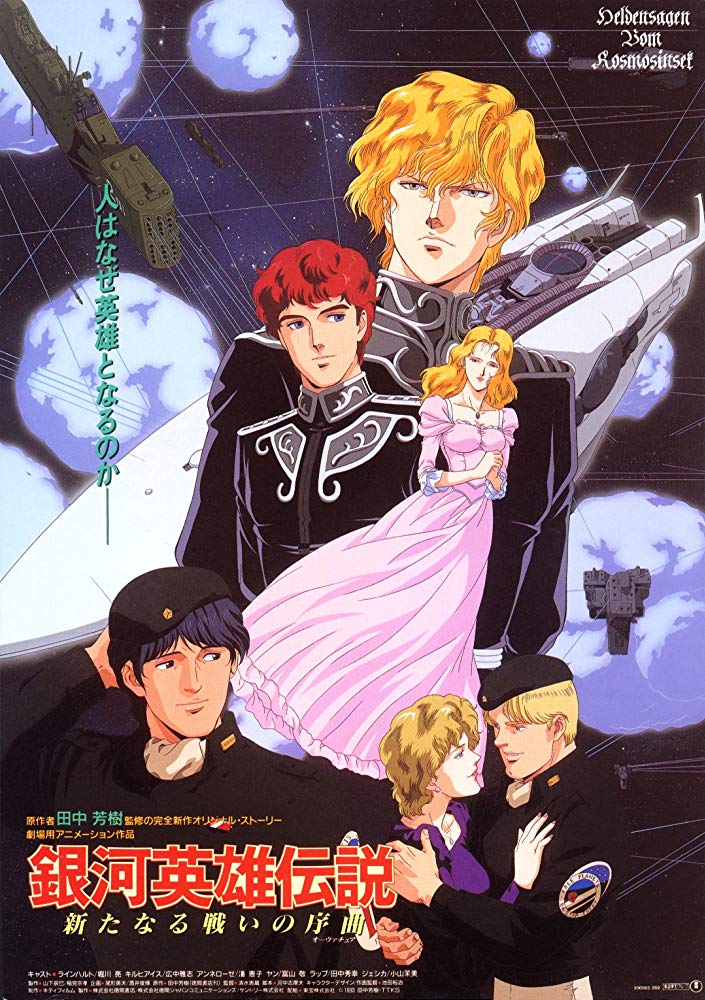
The proverbial “second season” of Legend of Galactic Heroes: Die Neue These is already well underway, with the second of three films set for October 25, 2019. While both newcomers and long-time fans alike have something to look forward to, you might be inclined to ask: What is Legend of Galactic Heroes? Hopefully, this guide will give you, whether a complete beginner or a seasoned otaku, a decent taste of what to expect.
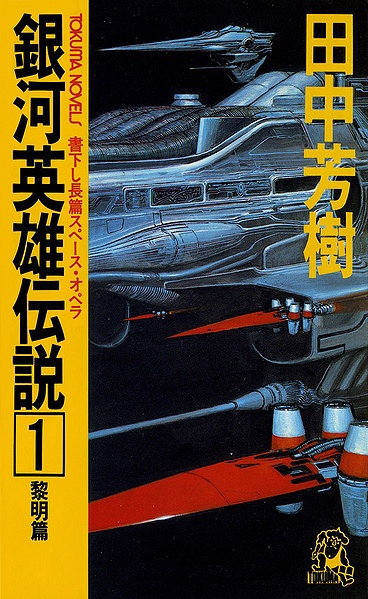
Legend of Galactic Heroes, also known as Ginga Eiyū Densetsu and Heldensagen vom Kosmosinsel (Gratuitous German for “Heroic tales from the cosmic island”), is a long-running franchise that combines space opera ala Star Wars with military science fiction reminiscent of Starship Troopers and a heaping of history. Originally a series of 10 novels by Dr. Yoshiki Tanaka (of The Heroic Legend of Arslan fame) and myriad side stories published between 1982 and 1989, it has expanded to include various series, OVAs, side stories, and manga adaptations. With so much already produced, it’s easy to be overwhelmed.
https://www.youtube.com/watch?v=RcFWzv-Y55k
Preview for the “second season” of Legend of Galactic Heroes: Die Neue These, showing both how far the franchise has come and how consistent it remains. Circa 2019. (Source: YouTube)
Let’s delve into the actual plot.
A Long Time from Now, in a Galaxy that’s Our Own…

Legend of Galactic Heroes opens up to the backdrop of a long interstellar war, sometime in the 36th Century AD. In one camp is the Galactic Empire, a heavily Germanic absolute monarchy under the rule of the Goldenbaum dynasty, where backstabbing aristocrats and decadence seem to be the order of the day. On the other side is the Free Planets Alliance, based on various Western democracies, yet seething with corruption and social unrest under a barely functional government. While the two great powers of the universe find themselves in a seemingly endless stalemate, where skirmishes among opposing fleets can cost millions of lives, the nominal Imperial border world of Fezzan presents itself as a neutral trading hub profiting from both sides.
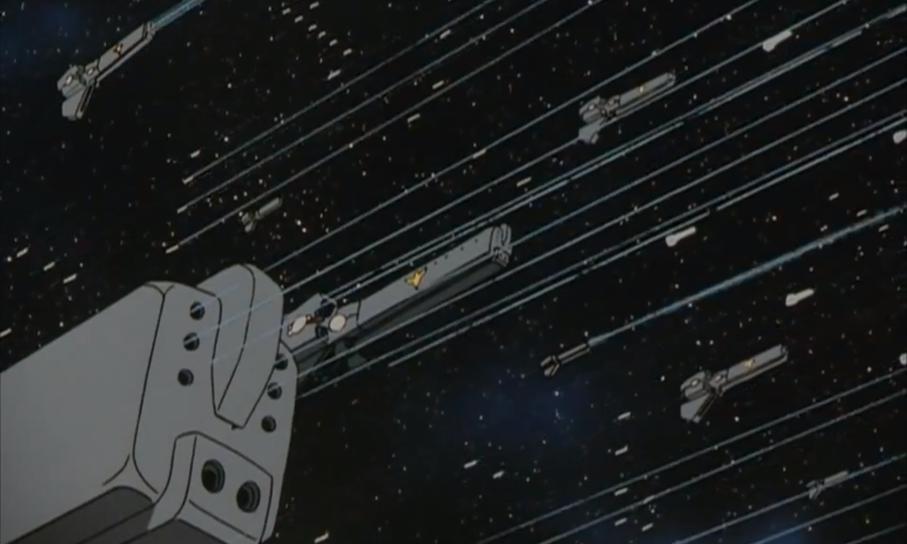
Into this conflict step two focal characters. In the Empire, an ambitious young noble named Reinhard von Musel (later known as Reinhard von Lohengramm) has risen up the ranks to become a skilled admiral in his own right. All that, however, is part of a plot to rescue his sister, topple the Goldenbaums and seize the universe. Meanwhile in the Alliance, Yang Wen-li, a brilliant if sloppy man with little love for being in the military, is also rapidly gaining fame as a war hero for his talents and dedication to democracy. Despite his own efforts to retire and pursue his true passion of being a historian, however, his actions propel him to ever new heights – and new dangers. The actions of these individuals and those around them would shape the course of human history forever.
Mind, that’s only the overall gist of what LoGH is all about. The backstory alone, whether in the original novels or in the myriad side stories, stretches well over a thousand years of mankind’s history. Whether it’s a nuclear war sometime in the 2030s, the myriad conflicts and planetary regimes leading up to the rise of Rudolf von Goldenbaum as the first Galactic Emperor, or the emergence of two separate calendars (the “Imperial Calendar” and “Universal Calendar”), it’s evident that much thought was put into world-building. This same care is evident throughout, such as in rationalizing the distinct cultures of both major powers and why the Death Star-like Iserlohn Fortress exists. It’s almost as if there’s a whole galaxy unfolding before your very eyes.
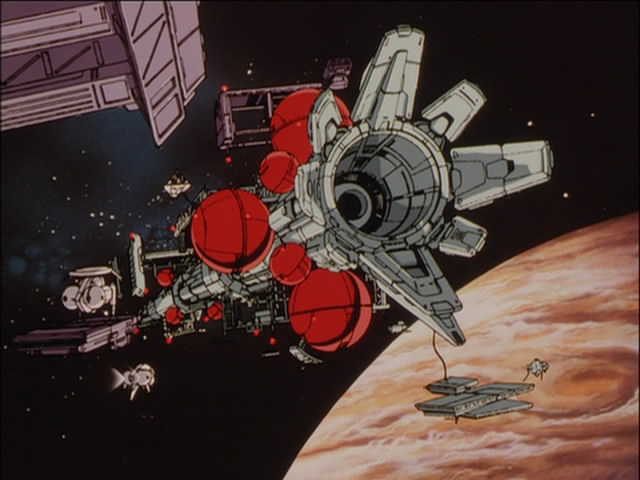
Then, there’s the interplay of realism amidst the sci-fi elements. For all the grand spaceships and lasers, there’s a consideration for things like logistics, tactics, and strategic planning, from the lowliest grunts up through the chain of command. The political theater is also highlighted, from the cutthroat intrigue of the Imperial court to the machinations and power plays within the Alliance, what happens behind the scenes could be just as significant as on the frontlines. Similarly emphasized alongside the grandeur of combat is the horror and cost of war, be it in the toll on society or the death of loved-ones on both sides.
Which isn’t to ignore the role played by history. Whatever rendition of the series you’re looking into, the historic references are many, partly due to Tanaka’s own passion for the past. Through bits of exposition, in-universe records, allusions in certain events and overt references, you’re bound to learn quite a bit about myriad aspects of Western and Asian cultures. This can go well past references to Clausewitz and Sun Tzu in how Reinhard and Yang wage war, extending even down to the symbolism of flowers in the Empire being based on actual German conventions.
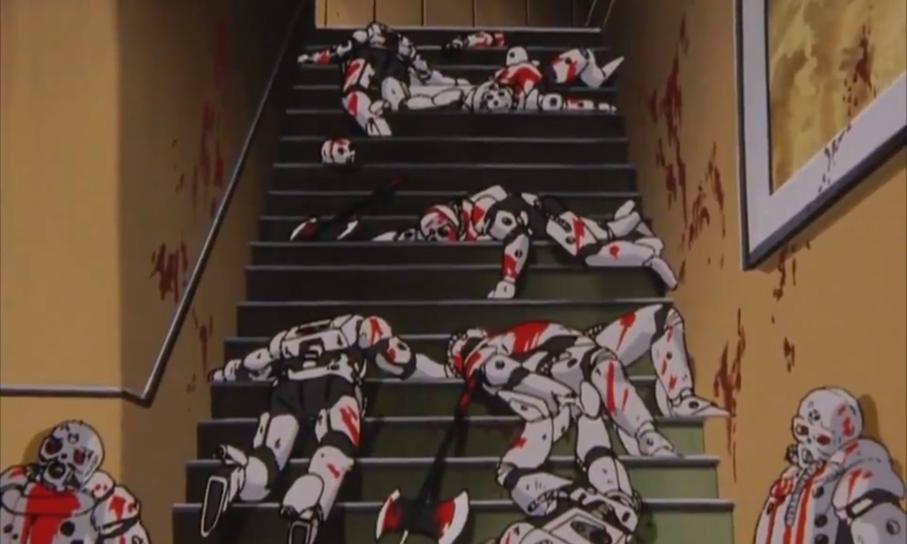
While the author’s not afraid to make commentary on human nature and conflict (such as in some of Yang’s monologues), the lines between good and evil are far from straightforward. While the Empire, for instance, may have been founded on blood, it’s also shown to be competent and open to reform, host to as many sympathetic characters (including honorable nobles) as there are depraved ones. The Alliance, meanwhile, as much as it might like to be the Rebellion in Star Wars, is rife with corrupt officials and parasitic opportunists, yet also has genuine patriots and defenders of democracy. There are heroic figures, villains, and everyone in between on various sides, showing both the best and worst of humanity. The overall ambiguity leaves it ultimately for you to decide who to root for.
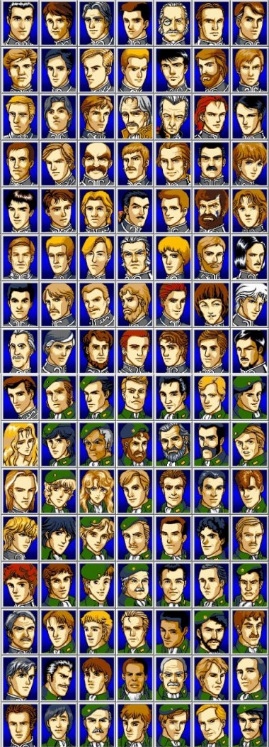
Legend of Galactic Heroes is infamous for having an absurd number of named figures (TvTropes listing 660 in total), of which about a hundred would be considered major characters, and that’s not even counting the named flagships like the Brünhild and Hyperion. Impressively, these main characters remain distinct and memorable. For the Imperial side alone, you have the likes of Reinhard’s closest friend Siegfried Kircheis, the military duo of Wolfgang Mittermeyer and Oskar von Reuenthal, the manipulative yet genuinely loyal Paul von Oberstein, and the reformist if similarly conniving Hildegard von Mariendorf. Which isn’t to forget Yang’s adopted ward-turned-veteran Julian Mintz, the gentle yet firm Frederica Greenhill, bureaucratic family man Alex Cazerne, or the ex-Imperial wildcard commander Walter von Schönkopf. Their relationships, personal struggles, tragedies, and victories alike make the setting relatable and drive home the epic scale of the saga.
Since the 1980s, there have been several adaptations of the books into various media. Two manga based on the series have been made, first by Katsumi Michihara (from 1990 to 2000) and the next by Ryū Fujisaki of Shiki fame (2015 onwards). It’s been made into several Japan-exclusive video games, the most recent being from 2008 and published by Namco Bandai. It’s been brought onto the theatrical stage several times, complete with a musical by the Takarazuka Revue in 2012.
Snippet from Special Performance: Loci of Stars, one of the on-stage theatrical adaptations of LoGH. Circa 2015. (Source: YouTube)
The most notable adaptations, however, would have to be the two main anime series, which have come to define the franchise.
The “Original” OVAs
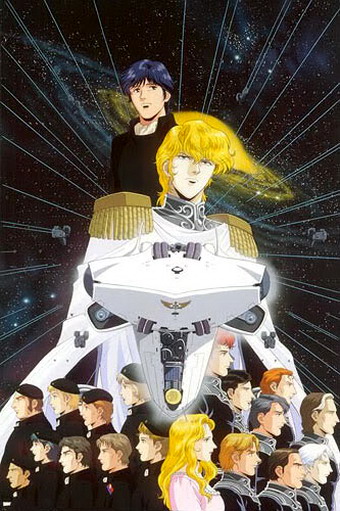
It’s nearly impossible to talk about Legend of Galactic Heroes without mentioning the “original” OVAs from Artland Inc., Madhouse (for the first 26 episodes) and Magic Bus. It is (in)famous for being not only the longest adaptation of the novels, but also one of the longest-running anime works ever made, without hyperbole. To understand that point, the “main” 110 episodes alone (with a total of over 2,800 minute’s worth of footage) were released as direct-to-video seasons or “series” over the course of nearly a decade, broken up as follows:
- “Series 1” from December 1988 to June 1989. (26 episodes)
- “Series 2” from July 1991 to February 1992. (28 episodes)
- “Series 3” from July 1994 to February 1995. (32 episodes)
- “Series 4” from September 1996 to March 1997. (It included 24 episodes)
This isn’t counting the three OVA films My Conquest is the Sea of Stars (1988), Golden Wings (1992), and Overture to a New War (1993), or the 52-episode prequel series Legend of Galactic Heroes Gaiden (1998-2001), which adopted the side stories. Put together, it’s little wonder why trying to watch the entire run can seem as harrowing as some of the franchise’s more grueling battles.
The OVAs are known for their execution in bringing the source material to life. Whether it’s the use of abstract graphs and fleet formations alongside the graphic consequences of actual combat (which include firefights with laser weapons and death by axe-wielding foes in power-armor), the screentime provided to major and even one-off characters, or the sheer scope of what a space battle would be like, there’s no lack of spectacle. Even in the more cerebral and quiet moments, of which there are many, there’s considerable emphasis put on dialogue that comes across as natural and often poignant, such as Yang admitting to his own biases in his philosophical moments and the snarky yet gentlemanly retorts by Reinhard’s subordinates. This isn’t counting some of the small touches by the animators, such as having an arc involving Kircheis dealing with a rebellious Imperial governor being inspired in part by the assassination of Julius Caesar. The use of classical music (as varied as Bruckner and Dvorak) for much of the soundtrack, even during the gorier scenes, adds a Wagnerian overtone worthy of a space opera, complemented by songs in English like “Skies of Love” by Michiru Akiyoshi.
The confrontation between Reuenthal and Schonkopf, highlighting both the bloodshed present in the more action-packed moments and the use of classical music to complement said bloodshed. (Source: YouTube)
The cast’s performances are also notable. With a cast like Ryo Horikawa as Reinhard, Norio Wakamoto as Reuenthal, and the late Kei Tomiyama as Yang, the OVAs managed to make otherwise subdued lines or deceptively dull moments seem weighty and meaningful. Even when nothing seems to be happening, the delivery is such that the personalities of those characters shine through. Over the entire run, several voice actors have shown up playing even bit-roles, including a number of Gundam seiyuu such as Toru Furuya, Shuichi Ikeda, and the late Ichirō Nagai.
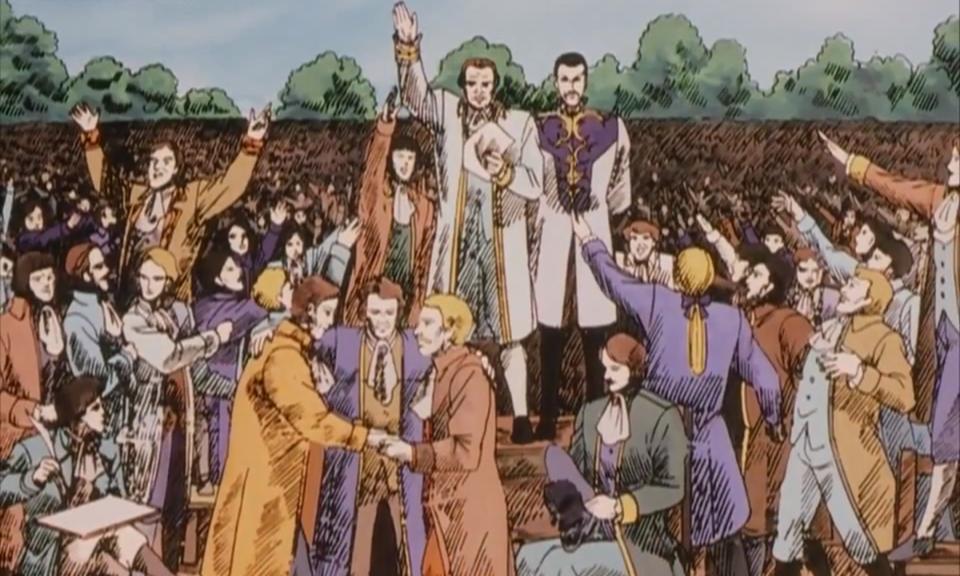
The pacing is such that it’s not unheard of for military operations to be planned out over the course of whole episodes before they’re put into action. The use of German and English can also leave a lot to be desired for native speakers, though it’s not without its charm. Animation quality can vary considerably as well, with the best usually reserved towards the major battles and the latter half of the run. In addition, aspects of it can come off very much as a product of its time, such as the ‘80s bishoujo look of certain characters like Reinhard (complete with long wavy hair), Willibald Joachim von Merkatz strongly resembling action star Charles Bronson, and the use of dated technology like floppy disks.
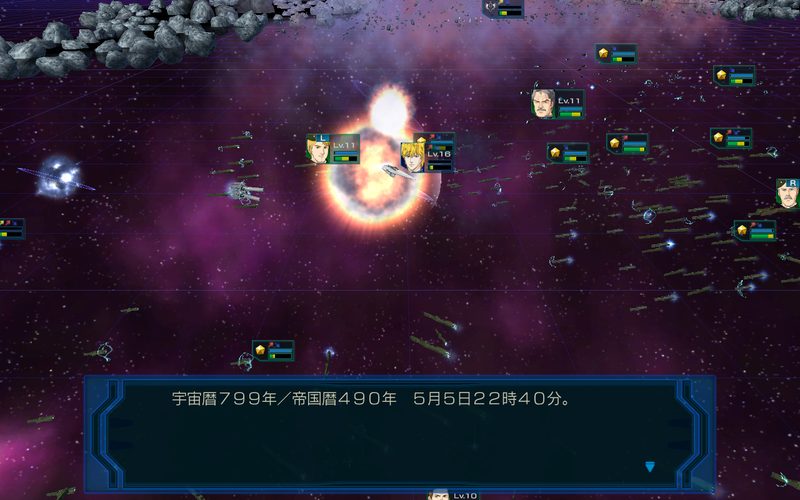
Even with such issues, the OVAs retain a timelessness and reward your patience with more than sufficient payoff. It’s not for nothing that, right or wrong, they have come to be seen by long-time fans as close to being the definitive adaptation of the novels. Indeed, aspects of them, such as the general appearance of the characters and the distinct design of each faction’s spaceships (like the sleeker aesthetics of Imperial vessels compared to the much more utilitarian Alliance ones), have been carried over in one way or another in subsequent works. The flip-side, however, is that any serious attempt to create a new anime take on the franchise would inevitably be compared to these “originals.”
This hasn’t stopped one studio from trying, however. More on that in Part 2, coming next week.


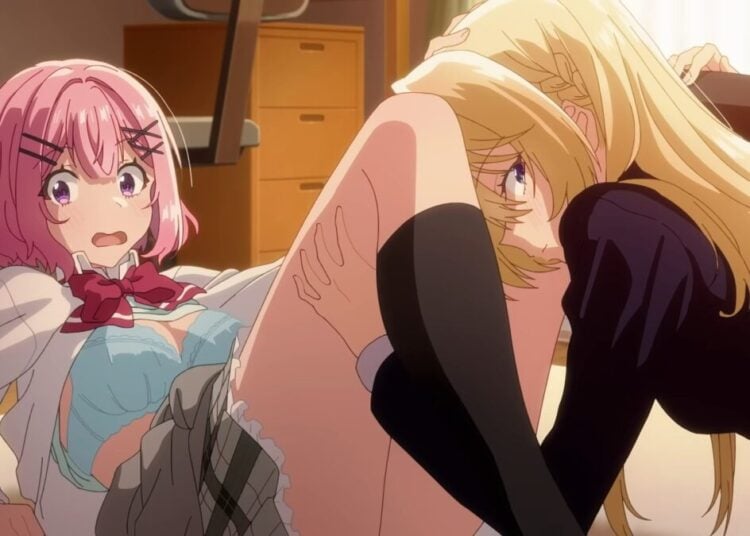
![Sawaranaide Kotesashi Kun Episode 12 [END] Featured Image](https://blog.jlist.com/wp-content/uploads/2025/12/Sawaranaide-Kotesashi-kun-Episode-12-END-Featured-Image-750x536.jpg)




